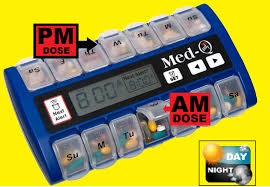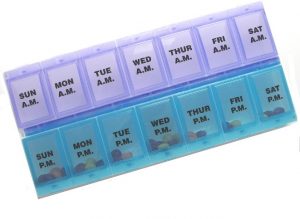5. Medications remainder boxes (MRB):
-
5.1. Medications remainder boxes (MRB)

Not taking prescribed medication – noncompliance – can have serious health consequences. The reasons why people forget or don’t take medications are varied. Maybe the doctor didn’t explain how to take it properly. Maybe they feel better and think they don’t need the medicine anymore. Maybe they just forgot.
Medication Reminder Box (MRB): a container that is compartmentalized and designed to hold medications for distribution according to a time element such as day, week, or portions thereof.
A pill organizer, pill container, or pillbox is a special container for storing scheduled doses of one’s medications. Pill organizers usually have square-shaped compartments for each day of the week, although other more compact and discreet versions have come to market, including cylindrical and pen-shaped cases. Some organizers have multiple sections, corresponding with different times of the day. Pill organizers are viewed as a way to prevent or reduce medication errors on the part of the patient.
MRBs are useful for all types of clients, including the elderly, those who have memory deficiencies, and those taking multiple medications, as an aid in remembering to take proper doses of their medications thereby complying with their doctor’s recommended dose, allow a patient to know whether or not they have taken a particular dose of their medication; if a pill still remains in its compartment, it is apparent that it has not yet been taken, whereas if it is missing, it has already been taken.
MRBs often have various features to make them easier for special-needs patients to use, such as color-coding, Braille for the blind, or a locking mechanism to prevent double dosing.[ Some organizers used for diabetes patients have sections for insulin and hypodermic syringes.
Some QMAPs will pre-load pills into pill organizers for their patients, as a convenient service
The most common type of medication system is the simple box with slots for different times of day. Caregivers sort out medications generally up to one week in advance and place it in the correct slot. At the appropriate time, the patient or the caregiver can tell at a moment’s glance which medicines need to be taken when.

Electronic pill organizers, pill dispensers, and pill reminders have been developed that alert patient when their prescription medication, OTC medication, or daily food supplements must be taken. These devices have been credited with saving lives and saving money in the health care system. Advanced models can be linked via the Internet to a medical facility, to aid in monitoring and reminding a client to take his/her medications. MRB with electronic alarms can look similar to an alarm clock and have settings for several different medications. These need to be programmed in advance by the caregiver so that the client is not easily confused by the device. One alarm vibrates strong enough when placed inside a pillowcase that it will wake the client to remind them that they need to take medication.

- MRB’s can be filled up to fourteen (14) days in advance. Successful completion of this course allows QMAP to fill MRB’s with supervision by a licensed professional or qualified manager. Regulations also allow medication reminder boxes used in designated facilities to be filled by the client, the family or a friend.
- There must be a complete label firmly attached to the box. This requires the name of the client, the name of each medication, dosage, quantity, route, and the specific time that each med is to be administered. If the design of the box does not permit firm attachment of the complete label, the MRB cannot be used by the QMAP.
- There must be a MAR for recording all drugs placed in the MRB and monitored or administered by staff. A client “self-administering” medication may fill his/her own MRB and utilize this method for storing medication prior to taking his/her medication. Medications that are “self-administered” from a MRB must be properly labeled but do not need to be documented on a MAR.
- If there is a physician ordered the change in the client’s medications, the facility must stop the use of the MRB until the designated QMAP, nurse or family member/friend has corrected the MRB according to the new order.
Certain medications may not be placed in a MRB:
- – Controlled substances;
- – PRN medications;
- – liquid medications;
- – medications with special instructions, such as “30 minutes prior to lunch”;
- – powders, inhalers, ointments, and creams.
- Ø QMAP’s “shall be familiar with the type and quantity of medication in each compartment of the box.” If the QMAP suspects that the tabs/caps in the MRB are not consistent with the label on the MRB the QMAP administering medications must not proceed with the administration of medications from the MRB until the problem is resolved.
- Ø The QMAP should not correct the discrepancy; a licensed person, qualified manager or the QMAP who filled the MRB should resolve difference(s).
A qualified medication manager must oversee a QMAP filling a MRB. The qualified manager should check the filling of the MRB’s weekly during at least the first two (2) times the MRBs are filled by a new QMAP, or by a QMAP who is a new employee and periodically thereafter. A qualified manager must be available for consultation whenever a MRB is being filled.
-
5.2. The steps needed to fill the MRB accurately and safely according to written physician orders
- Wear gloves when handling medications, especially if you touch pills or clients.
- Fill the MRB in a safe, quiet, secure area, free from interruptions from staff, clients and telephone calls. This avoids errors caused by distractions.
- Check all MRBs prior to filling for cleanliness and good repair.
- Fill the MRB for only one client at a time. This avoids filling the MRB with the wrong client’s medications.
Steps:
Step 1: Cross-check the MRB label with the physician order, the MAR and the pharmacist-prepared medication bottle.
a) The label on the MRB should reflect the exact number(s) of each tablet/capsule of medication to be placed in the MRB.
b) b. If the label on the MRB does not match the information on either the physician order, the MAR or the medication bottle, you must resolve the discrepancy before filling the MRB. This includes verifying that trade and generic names used are the same drugs.
c) Always ask for assistance when unsure of an order, a medication, a label or the procedure used in filling MRB’s. You are responsible to know your facilities’ policies and procedures for filling and for administering or monitoring medications from MRB’s.
Step 2: Wash hands immediately before opening medication bottles. Apply gloves.
a) Transfer medications from bottle lid to MRB or transfer medication wearing gloves. Never touch pills with bare hands.
b) If desired, you may use clean tweezers in transferring medications from bottle lid to MRB; alcohol wipes are acceptable for cleaning tweezers.
Step 3: Using an organized system, each medication on the MRB label is filled, one at a time, until all medications for the client have been completed. Count the number of medications in the MRB and compare it to the MRB’s label.
Step 4: After filling is completed, count or estimate the number of pills remaining in the bottle. Enough medications should be in the bottle for at least ten (10) days if possible or as insurance allows. Find out from your facility your responsibility regarding the reordering of.
-
5.3. Medication Administration Regulations
6 CCR 1011-1 Chap 24
SECTION 8 – MEDICATION REMINDER BOXES OR SYSTEMS
8.1 Residents or clients who self-administer medication may use medication reminder boxes. Facilities using medication reminder boxes for persons who are not self-administering shall have a nurse or qualified medication administration person available to assist with or administer from the medication reminder box.
8.2 Only authorized practitioners, nurses or qualified medication administration persons are allowed to assist residents or clients with medication reminder boxes.
(A) Each qualified medication administration person assisting a resident or client with a medication reminder box shall be familiar with the type and quantity of medication in each compartment of the box.
8.3 Each qualified medication administration person assisting with or administering from a medication reminder box shall, immediately after assisting or administering, record the assist or administration on medication administration record forms developed or acquired and maintained by the facility.
(A) The medication administration record shall contain complete instructions for the administration of each medication.
(B) The medication administration record shall contain a specific entry for each medication given that includes the date, time and amount of the medication, and the signature of the person administering the medication.
8.4 The facility shall be responsible for administering the correct medications to its residents or clients in a manner consistent with the provisions of section 25-1.5-303, C.R.S.
8.5 Medication reminder boxes or systems are allowable only if such containers have been filled and properly labeled by a pharmacist licensed pursuant to Article 42.5 of Title 12, C.R.S., a nurse licensed pursuant to Article 38 of Title 12, C.R.S, a qualified medication administration person, or through the gratuitous care of family members or friends of the resident or client.
8.6 The facility shall ensure that a label is attached to each medication reminder box.
(A) The information on the label shall include the name of the resident or client, each medication, the dosage, the quantity, the route of administration, and the time that each medication is to be administered.
(B) The facility shall ensure that each medication reminder box has a corresponding medication administration record where all administrations are documented immediately after administration.
(C) If an authorized practitioner orders a change in any medication for the resident; the facility shall discontinue use of the medication reminder box until it has been properly refilled according to the change ordered.
8.7 If any medication in the medication reminder box is not consistent with the labeling, the qualified medication administration person shall not administer the medication to the resident or client and shall immediately notify the proper person as outlined in the policies and procedures of the facility.
(A) For purposes of this paragraph, the proper person shall be whoever filled the medication reminder box or the authorized practitioner who prescribed the medication(s).
(B) Once the problem with the medication(s) is resolved and all medications are correctly assigned to the appropriate compartments of the medication reminder, the qualified medication administration person may resume the administration or assistance to the resident or client from the medication reminder box.
8.8 Any medication problem shall be resolved prior to the next administration.
8.9 PRN or “as needed” medications of any kind shall not be placed in a medication reminder box. Only medications intended for oral ingestion shall be placed in the medication reminder box.
(A) Medications that require administration according to special instructions, including but not limited to instructions such as “30 minutes or an hour before meals,” rather than administered routinely shall not be placed in a medication reminder.
8.10 Medications in the medication reminder box shall only be used at the time specified on the box. Medication reminder boxes shall not be filled for more than two weeks at a time.
8.11 Any medication reminder “day packs” or individual “trip packs” assembled for administration outside the facility shall comply with the requirements of this section 8.